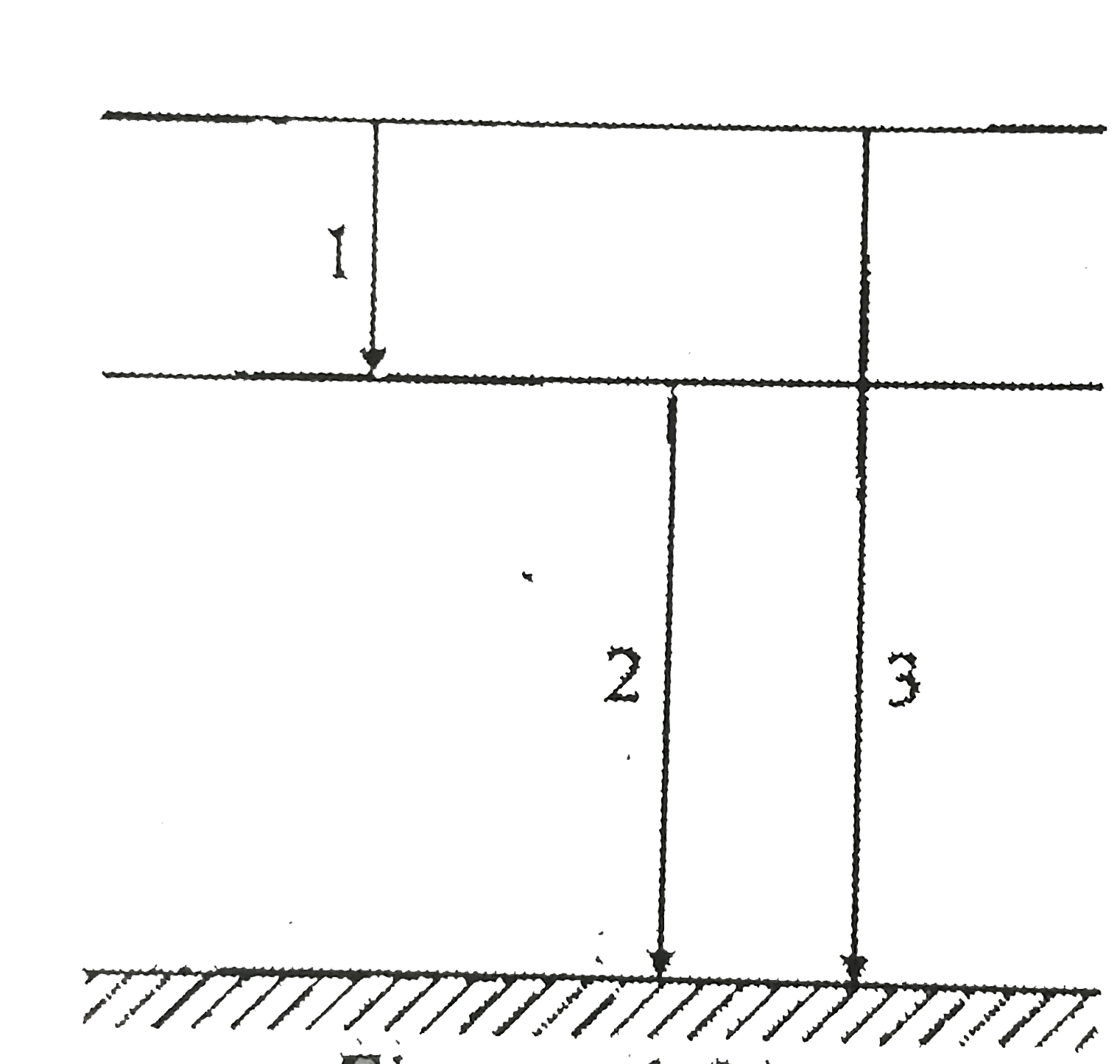Cut off potential for a metal in photoclectric effect for light of wavelength λ1,λ2 and λ3 is found to be V1,V2 and V3 volts , If V1,V2 and V3 are in Arithmetic progression then λ1,λ2 and λ3 will be in
Arithmetic progression
Geometric progression
Harmonic progression
None of these
The correct Answer is:C
To solve the problem, we need to analyze the relationship between the cutoff potentials V1,V2,V3 and the wavelengths λ1,λ2,λ3 in the context of the photoelectric effect.
1. Understanding the Photoelectric Effect:
The photoelectric effect is described by the equation:
E=hν=hcλ=ϕ0+KE
where E is the energy of the incident photon, h is Planck's constant, c is the speed of light, λ is the wavelength, ϕ0 is the work function, and KE is the kinetic energy of the emitted electrons.
2. Relating Potential to Wavelength:
The cutoff potential V is related to the energy of the photon and can be expressed as:
eV=hcλ−ϕ0
Rearranging gives:
V=hceλ−ϕ0e
This shows that the potential V is inversely proportional to the wavelength λ.
3. Setting Up the Arithmetic Progression:
Given that V1,V2,V3 are in arithmetic progression, we have:
2V2=V1+V3
4. Expressing Wavelengths in Terms of Potentials:
From the equation for potential, we can express V1,V2,V3 as:
V1=hceλ1−ϕ0e,V2=hceλ2−ϕ0e,V3=hceλ3−ϕ0e
5. Substituting into the AP Condition:
Substituting these expressions into the AP condition:
2(hceλ2−ϕ0e)=(hceλ1−ϕ0e)+(hceλ3−ϕ0e)
Simplifying this leads to:
2hceλ2=hceλ1+hceλ3
6. Cancelling Common Terms:
We can cancel hce from both sides:
21λ2=1λ1+1λ3
7. Identifying the Progression:
The equation 21λ2=1λ1+1λ3 indicates that λ1,λ2,λ3 are in harmonic progression because the reciprocals of the wavelengths are in arithmetic progression.
Conclusion:
Thus, if V1,V2,V3 are in arithmetic progression, then λ1,λ2,λ3 will be in harmonic progression.
The photoelectric effect is described by the equation:
E=hν=hcλ=ϕ0+KE
where E is the energy of the incident photon, h is Planck's constant, c is the speed of light, λ is the wavelength, ϕ0 is the work function, and KE is the kinetic energy of the emitted electrons.
The cutoff potential V is related to the energy of the photon and can be expressed as:
eV=hcλ−ϕ0
Rearranging gives:
V=hceλ−ϕ0e
This shows that the potential V is inversely proportional to the wavelength λ.
Given that V1,V2,V3 are in arithmetic progression, we have:
2V2=V1+V3
From the equation for potential, we can express V1,V2,V3 as:
V1=hceλ1−ϕ0e,V2=hceλ2−ϕ0e,V3=hceλ3−ϕ0e
Substituting these expressions into the AP condition:
2(hceλ2−ϕ0e)=(hceλ1−ϕ0e)+(hceλ3−ϕ0e)
Simplifying this leads to:
2hceλ2=hceλ1+hceλ3
We can cancel hce from both sides:
21λ2=1λ1+1λ3
The equation 21λ2=1λ1+1λ3 indicates that λ1,λ2,λ3 are in harmonic progression because the reciprocals of the wavelengths are in arithmetic progression.
Thus, if V1,V2,V3 are in arithmetic progression, then λ1,λ2,λ3 will be in harmonic progression.
Topper's Solved these Questions
- MODERN PHYSICSBOOK - DC PANDEY ENGLISHCHAPTER - MODERN PHYSICSEXERCISE - for JEE Advanced (only one option is Correct)
76 Videos
- MODERN PHYSICSBOOK - DC PANDEY ENGLISHCHAPTER - MODERN PHYSICSEXERCISE - for JEE Advanced (More than One Options is Correct )
1 Videos
- MAGNETISM AND MATTERBOOK - DC PANDEY ENGLISHCHAPTER - MAGNETISM AND MATTEREXERCISE - Medical gallery
1 Videos
- MODERN PHYSICS - 1BOOK - DC PANDEY ENGLISHCHAPTER - MODERN PHYSICS - 1EXERCISE - Level 2 Subjective
23 Videos
Similar Questions
The ratio of resolving power of an optical microscope for two wavelength λ1=4000Å and λ2=6000Å is:
View SolutionLet K1 be the maximum kinetic energy of photoelectrons emitted by a light of wavelength λ1 and K2 corresponding to λ2). If λ1=2λ2, then
View SolutionTwo sound waves of wavelengths λ1 and λ2(λ2>λ1) produces nbeats/s , the speed of sound is
View SolutionTransition between three energy energy levels in a particular atom give rise to three Spectral line of wevelength , in increasing magnitudes. λ1,λ2 and λ3. Which one of the following equations correctly ralates λ1,λ2 and λ3?
View SolutionTransition between three energy energy levels in a particular atom give rise to three Spectral line of wevelength , in increasing magnitudes. λ1,λ2 and λ3. Which one of the following equations correctly ralates λ1,λ2 and λ3?
λ1=λ2−λ3
λ1=λ3−λ2
1λ1=1λ2+1λ3
1λ2=1λ3+1λ1
View SolutionThe wavelengths and frequencies of photons in transition 1,2 and 3 for hydrogen like atom are λ1,λ2,λ3,v1,v2 and v3 respectively. Then:

View SolutionLights of wavelengths λ1=4500Å,λ2=6000Å are sent through a double slit arrangement simultaneously. Then
View SolutionShow that if λ1,λ2,....,lamndan are n eigenvalues of a square matrix a of order n, then the eigenvalues of the matric A2 are λ21,λ22,...,λ2n.
View SolutionLast line of Lyman series for H− atom has wavelength λ1A,2nd line of Balmer series has wavelength λ2A then
View SolutionIf λ1andλ2 are the wavelength of the first members of the Lyman and Paschen series, respectively , then λ1:λ2 is
View Solution
